Quickbooks - Payroll Link
Integration Of CollSoft Payroll And QuickBooks
One of the new features added to CollSoft Payroll is the ability to post your payroll data directly from Payroll into Intuit QuickBooks, whereby you export your payroll data to an intermediary file which is then imported into QuickBooks.
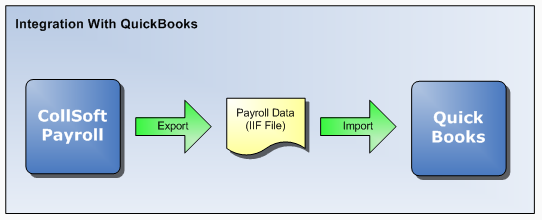
Quickbooks - Payroll Link: Integration with Quickbooks
Before you can export any data from CollSoft Payroll you must define the nominal accounts that the various entries get posted to.
When you have defined your nominal mappings you are then ready to export from CollSoft Payroll and import into QuickBooks.
Setting Up QuickBook Link
Before using the QuickBooks Nominal interface there are some settings that you must configure in your company. These settings are required so that CollSoft Payroll can post the various transactions associated with a wage to the correct nominal accounts.
Accessing the QuickBooks Nominal Settings
To edit the QuickBooks Nominal settings for your company you should do the following
1. Open the Company screen for the company in question.
2. Press the Nominal Settings button on the Misc. tab of the Company screen.
3. You will now see the QuickBooks Nominal Interface Settings screen.
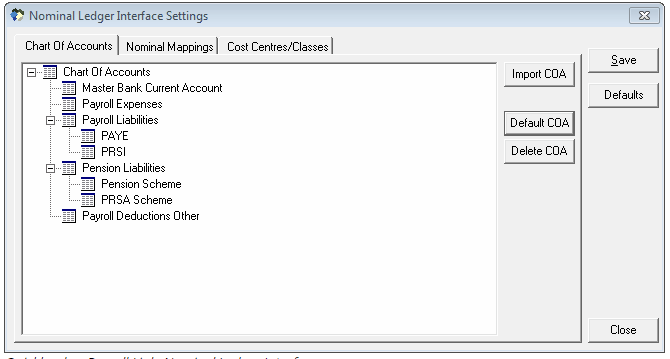
Quickbooks - Payroll Link: Nominal Ledger Interface
Chart Of Accounts
Before you can create any nominal mappings you must specify the Chart Of Accounts that you want to use. CollSoft Payroll includes a default Chart Of Accounts (shown in above screen shot), but you can import your existing QuickBooks Chart Of Accounts.
Importing Your Chart Of Accounts From QuickBooks
Importing the Chart Of Accounts from QuickBooks is essentially a two step procedure where you export your Chart Of Accounts from QuickBooks and then import it into CollSoft Payroll as follows:
1. Start QuickBooks and open the company that you will be importing your Payroll data into.
2. Select Export from the File > Utilities menu.
3. Select Chart Of Accounts from the Export Window.
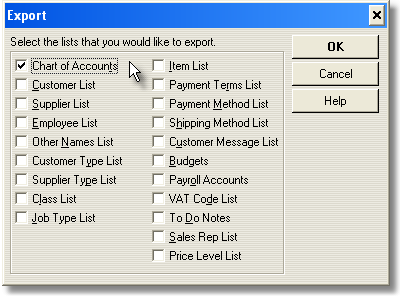
Quickbooks - Payroll Link: Chart of Accounts
4. You will be asked where you want to save the .IIF file containing your Chart Of Accounts.
5. A message confirming that the export was completed successfully will be displayed.
6. Now, start CollSoft Payroll and open the relevant company.
7. Open the QuickBooks Nominal Interface Settings as shown above.
8. Press the Import button on the Chart Of Accounts tab.
9. You will be warned that if you proceed with the import your existing nominal account mappings will be lost.
10. Next you must specify the file to be imported. Select the file you created in step 4.
11. CollSoft Payroll will read the contents of the IIF file and update the Chart Of Accounts screen.
Nominal Mappings
Before you can export your payroll data to QuickBooks you must specify the accounts to which the various costs and liabilities are posted. CollSoft Payroll allows great flexibility in how such items are posted to your accounts. The items that can be exported are categorised as follows:
Pay Items
Pay Items include all standard payment types such as Basic Pay, Holiday Pay, Hourly Pay etc. These items would normally be posted to Expense accounts so that they appear in the Profit & Loss report. Each pay item can be posted to either a single or separate accounts depending on the detail that you require for your accounting.
Additions
Additions to pay would usually be posted to expense accounts. This section also includes an entry for BIK Loans to cater for Loans to an employee to cover a shortfall in his/her pay with respect to tax liabilities incurred from Benefit In Kind.
Deductions
This section allows you to specify how deductions (other than PAYE/PRSI) are posted to your accounts. Such deductions would usually (but not always) be assigned to Liability accounts.
Employer Costs
CollSoft Payroll has the facility to accrue other costs that are not directly related to payroll. For example, if an employee has a company car that is costing the employer 500 euro per month in re payments, then this indirect cost can be associated with the employee via Employer Costs. To use employer costs you must specify an account to be debited and an account to be credited
PAYE/PRSI Liabilities
These settings determine where PAYE/PRSI that is deducted from wages are recorded as liabilities due to be paid to Revenue. You must also specify the expense account to which Employers PRSI is charged
Bank
This section lets you specify the bank accounts that wages are paid from. CollSoft Payroll lets you specify a different bank account for each payment method (Cheque, Cash and Credit Transfer).
For employees that are paid by cash and credit transfer you are also able to specify how the transactions appear in the bank account as follows:
Batch Total For Period: When you choose this option a single entry for the total of all net payments for the period is recorded in the bank account (the expense accounts still show the employee breakdown). This can be useful for bank reconciliation purposes where the bank statement may only show a single entry for a complete weeks wages
Individual Entry Per Employee: When you choose this option then each net payment is recorded separately in the bank account.
Journal entries are created for employees that are paid by cash or credit transfer, while cheques are entered for employees who are paid by cheque. CollSoft Payroll does not allocate cheque numbers, this must be done separately from within QuickBooks.
Pension
The pension settings determine the expense accounts to which employer Pension/PRSA contributions are posted and the liability accounts to which pension liabilities are recorded
Exporting Your Payroll Data
Step 1 - Backup Your QuickBooks Data
Before you do anything else, you should create a backup of your QuickBooks data file. This can be done by selecting Back Up from the File menu in QuickBooks.
Step 2 - Starting the Nominal Ledger Export In CollSoft Payroll
The process of exporting your Payroll data from CollSoft Payroll is just a matter of running the Nominal Ledger Export Wizard. To run this wizard simply select the Nominal Ledger Export... option from the Payroll menu.
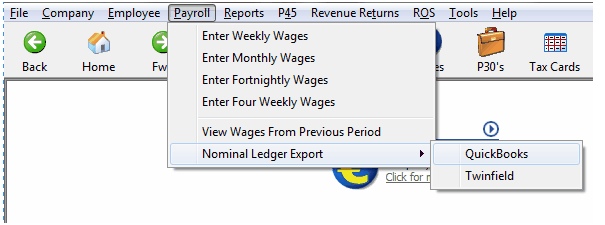
Quickbooks - Payroll Link: Select the Nominal Ledger Export
Step 3 - Specify Date Range For Export
This step requires you to specify the dates for the export. All wages (weekly & monthly) between these dates will be included in your export file.
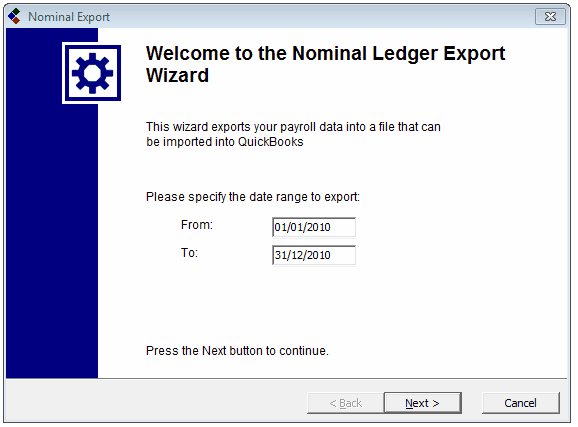
Quickbooks - Payroll Link: Enter Dates for Export
Note: It is very important that you do not choose dates that overlap with a previous export.
For Example: If you had previously exported all the wages between 1st Jan and 15th Jan, then the next export file should commence on 16th Jan. If you were to run the next export from 15th Jan then there is the possibility that wages on the 15th would be exported into QuickBooks twice!
Press the Next button to continue
Step 4 - Specify a Filename for the Export File
Specify a name for the export file, or click on the Browse button to navigate to the desired location.
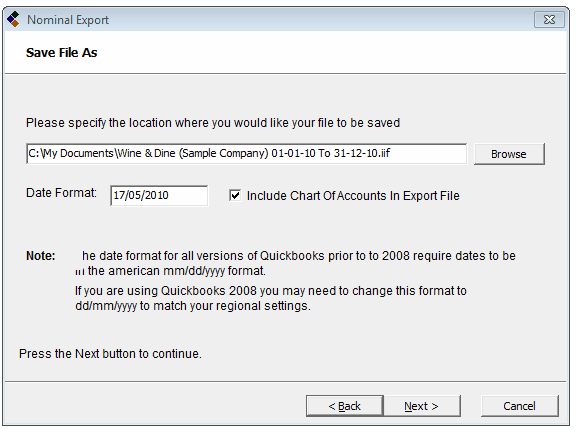
Quickbooks - Payroll Link: Select location to Save File
Press the Next button to continue. CollSoft Payroll will now process all the wages between the dates that you specified.
If the export process was successful you will be asked if you want to view a report of the postings. This report shows you a summary of the amounts
posted to each account, and a detailed breakdown on a wage by wage basis of the individual transaction involved.
Press the Finish button to close the wizard.
You are now ready to import your Payroll data into QuickBooks.
Errors That Can Occur
If for any reason CollSoft is not able to export your payroll data then you will be shown a list of errors at the end of the wizard (and your export file will not be created).
The most common reason for an export to fail is that there is an amount associated with a category that has not been mapped to a nominal account in your company settings.
For example, if you do not specify a bank account in your nominal settings then Payroll will be unable to post the net payments to each employee, and you will see a screen similar to the following:

Quickbooks - Payroll Link: Error Log
To rectify this problem review your nominal settings and try the export wizard again.
Importing Your Payroll Data Into QuickBooks
Step 1 - Export Payroll Data
Export your Payroll data from CollSoft Payroll. Click here for further instructions.
Step 2 - Start QuickBooks
Open QuickBooks and make a backup of your existing accounts data. (Select Back Up from the File menu)
Step 3 - Check Your Data
Print a trial balance report in QuickBooks by selecting Trial Balance from the Accountant & Taxes submenu of the Reports menu, choosing the appropriate dates.
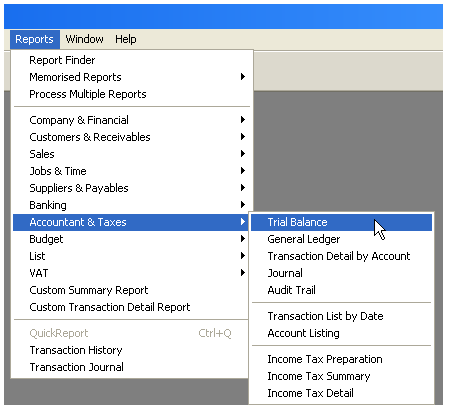
Quickbooks - Payroll Link: Print Trial Balance
Step 4 - Importing The Payroll Data
Select the Import IIF Files... option from the File>Utilities>Import menu in QuickBooks. This will start the QuickBooks import wizard that will import your payroll data into QuickBooks.

Quickbooks - Payroll Link: Import File into Quickbooks
Step 5 - Check The Postings
Re-run the Trial Balance report in QuickBooks. The difference between this trial balance and the one from step 3 should be accounted for by the summary of transactions reported at the end of the export process in CollSoft Payroll.
The individual splits from each wage entry can be seen by double clicking on the relevant entry in your bank account in QuickBooks, or by drilling down in the various reports in QuickBooks.
Limitations With QuickBooks Nominal Export
The following limitations apply to the QuickBooks Nominal Export feature in CollSoft Payroll. It is very important that you understand what they are before you start using the QuickBooks Nominal Export feature in CollSoft Payroll
1. Changes To Wages After Posting To Accounts: One of the unique features in CollSoft Payroll is the ability to make changes to wages in previous periods. If a user makes changes to a wage after it has been posted to QuickBooks then the user will have to manually update QuickBooks to reflect the change.
2. Posting Date: When you export wages from Payroll the various transactions are posted using the Pay Dates from CollSoft Payroll.
3.Overlapping Dates: The QuickBooks export feature in CollSoft Payroll is date driven - i.e. the output file contains all wage entries between two user specified dates. Users must take care not to export the same wages more than once. For example, if a user posts all the wages between 1st Jan and 31st Jan, then the next export should be from 1st Feb. If the user were to export from the 1st Jan to the 1st Feb, then the next export should be from 2nd Feb.
4. Importing Data Into QuickBooks More Than Once: The user must be extremely careful not to import the same Payroll export file into QuickBooks more than once. The only way to undo this operation is to restore a previous backup.
One of the new features added to CollSoft Payroll is the ability to post your payroll data directly from Payroll into Intuit QuickBooks, whereby you export your payroll data to an intermediary file which is then imported into QuickBooks.
Quickbooks - Payroll Link: Integration with Quickbooks
Before you can export any data from CollSoft Payroll you must define the nominal accounts that the various entries get posted to.
When you have defined your nominal mappings you are then ready to export from CollSoft Payroll and import into QuickBooks.
Setting Up QuickBook Link
Before using the QuickBooks Nominal interface there are some settings that you must configure in your company. These settings are required so that CollSoft Payroll can post the various transactions associated with a wage to the correct nominal accounts.
Accessing the QuickBooks Nominal Settings
To edit the QuickBooks Nominal settings for your company you should do the following
1. Open the Company screen for the company in question.
2. Press the Nominal Settings button on the Misc. tab of the Company screen.
3. You will now see the QuickBooks Nominal Interface Settings screen.
Quickbooks - Payroll Link: Nominal Ledger Interface
Chart Of Accounts
Before you can create any nominal mappings you must specify the Chart Of Accounts that you want to use. CollSoft Payroll includes a default Chart Of Accounts (shown in above screen shot), but you can import your existing QuickBooks Chart Of Accounts.
Importing Your Chart Of Accounts From QuickBooks
Importing the Chart Of Accounts from QuickBooks is essentially a two step procedure where you export your Chart Of Accounts from QuickBooks and then import it into CollSoft Payroll as follows:
1. Start QuickBooks and open the company that you will be importing your Payroll data into.
2. Select Export from the File > Utilities menu.
3. Select Chart Of Accounts from the Export Window.
Quickbooks - Payroll Link: Chart of Accounts
4. You will be asked where you want to save the .IIF file containing your Chart Of Accounts.
5. A message confirming that the export was completed successfully will be displayed.
6. Now, start CollSoft Payroll and open the relevant company.
7. Open the QuickBooks Nominal Interface Settings as shown above.
8. Press the Import button on the Chart Of Accounts tab.
9. You will be warned that if you proceed with the import your existing nominal account mappings will be lost.
10. Next you must specify the file to be imported. Select the file you created in step 4.
11. CollSoft Payroll will read the contents of the IIF file and update the Chart Of Accounts screen.
Nominal Mappings
Before you can export your payroll data to QuickBooks you must specify the accounts to which the various costs and liabilities are posted. CollSoft Payroll allows great flexibility in how such items are posted to your accounts. The items that can be exported are categorised as follows:
Pay Items
Pay Items include all standard payment types such as Basic Pay, Holiday Pay, Hourly Pay etc. These items would normally be posted to Expense accounts so that they appear in the Profit & Loss report. Each pay item can be posted to either a single or separate accounts depending on the detail that you require for your accounting.
Additions
Additions to pay would usually be posted to expense accounts. This section also includes an entry for BIK Loans to cater for Loans to an employee to cover a shortfall in his/her pay with respect to tax liabilities incurred from Benefit In Kind.
Deductions
This section allows you to specify how deductions (other than PAYE/PRSI) are posted to your accounts. Such deductions would usually (but not always) be assigned to Liability accounts.
Employer Costs
CollSoft Payroll has the facility to accrue other costs that are not directly related to payroll. For example, if an employee has a company car that is costing the employer 500 euro per month in re payments, then this indirect cost can be associated with the employee via Employer Costs. To use employer costs you must specify an account to be debited and an account to be credited
PAYE/PRSI Liabilities
These settings determine where PAYE/PRSI that is deducted from wages are recorded as liabilities due to be paid to Revenue. You must also specify the expense account to which Employers PRSI is charged
Bank
This section lets you specify the bank accounts that wages are paid from. CollSoft Payroll lets you specify a different bank account for each payment method (Cheque, Cash and Credit Transfer).
For employees that are paid by cash and credit transfer you are also able to specify how the transactions appear in the bank account as follows:
Batch Total For Period: When you choose this option a single entry for the total of all net payments for the period is recorded in the bank account (the expense accounts still show the employee breakdown). This can be useful for bank reconciliation purposes where the bank statement may only show a single entry for a complete weeks wages
Individual Entry Per Employee: When you choose this option then each net payment is recorded separately in the bank account.
Journal entries are created for employees that are paid by cash or credit transfer, while cheques are entered for employees who are paid by cheque. CollSoft Payroll does not allocate cheque numbers, this must be done separately from within QuickBooks.
Pension
The pension settings determine the expense accounts to which employer Pension/PRSA contributions are posted and the liability accounts to which pension liabilities are recorded
Exporting Your Payroll Data
Step 1 - Backup Your QuickBooks Data
Before you do anything else, you should create a backup of your QuickBooks data file. This can be done by selecting Back Up from the File menu in QuickBooks.
Step 2 - Starting the Nominal Ledger Export In CollSoft Payroll
The process of exporting your Payroll data from CollSoft Payroll is just a matter of running the Nominal Ledger Export Wizard. To run this wizard simply select the Nominal Ledger Export... option from the Payroll menu.
Quickbooks - Payroll Link: Select the Nominal Ledger Export
Step 3 - Specify Date Range For Export
This step requires you to specify the dates for the export. All wages (weekly & monthly) between these dates will be included in your export file.
Quickbooks - Payroll Link: Enter Dates for Export
Note: It is very important that you do not choose dates that overlap with a previous export.
For Example: If you had previously exported all the wages between 1st Jan and 15th Jan, then the next export file should commence on 16th Jan. If you were to run the next export from 15th Jan then there is the possibility that wages on the 15th would be exported into QuickBooks twice!
Press the Next button to continue
Step 4 - Specify a Filename for the Export File
Specify a name for the export file, or click on the Browse button to navigate to the desired location.
Quickbooks - Payroll Link: Select location to Save File
Press the Next button to continue. CollSoft Payroll will now process all the wages between the dates that you specified.
If the export process was successful you will be asked if you want to view a report of the postings. This report shows you a summary of the amounts
posted to each account, and a detailed breakdown on a wage by wage basis of the individual transaction involved.
Press the Finish button to close the wizard.
You are now ready to import your Payroll data into QuickBooks.
Errors That Can Occur
If for any reason CollSoft is not able to export your payroll data then you will be shown a list of errors at the end of the wizard (and your export file will not be created).
The most common reason for an export to fail is that there is an amount associated with a category that has not been mapped to a nominal account in your company settings.
For example, if you do not specify a bank account in your nominal settings then Payroll will be unable to post the net payments to each employee, and you will see a screen similar to the following:
Quickbooks - Payroll Link: Error Log
To rectify this problem review your nominal settings and try the export wizard again.
Importing Your Payroll Data Into QuickBooks
Step 1 - Export Payroll Data
Export your Payroll data from CollSoft Payroll. Click here for further instructions.
Step 2 - Start QuickBooks
Open QuickBooks and make a backup of your existing accounts data. (Select Back Up from the File menu)
Step 3 - Check Your Data
Print a trial balance report in QuickBooks by selecting Trial Balance from the Accountant & Taxes submenu of the Reports menu, choosing the appropriate dates.
Quickbooks - Payroll Link: Print Trial Balance
Step 4 - Importing The Payroll Data
Select the Import IIF Files... option from the File>Utilities>Import menu in QuickBooks. This will start the QuickBooks import wizard that will import your payroll data into QuickBooks.
Quickbooks - Payroll Link: Import File into Quickbooks
Step 5 - Check The Postings
Re-run the Trial Balance report in QuickBooks. The difference between this trial balance and the one from step 3 should be accounted for by the summary of transactions reported at the end of the export process in CollSoft Payroll.
The individual splits from each wage entry can be seen by double clicking on the relevant entry in your bank account in QuickBooks, or by drilling down in the various reports in QuickBooks.
Limitations With QuickBooks Nominal Export
The following limitations apply to the QuickBooks Nominal Export feature in CollSoft Payroll. It is very important that you understand what they are before you start using the QuickBooks Nominal Export feature in CollSoft Payroll
1. Changes To Wages After Posting To Accounts: One of the unique features in CollSoft Payroll is the ability to make changes to wages in previous periods. If a user makes changes to a wage after it has been posted to QuickBooks then the user will have to manually update QuickBooks to reflect the change.
2. Posting Date: When you export wages from Payroll the various transactions are posted using the Pay Dates from CollSoft Payroll.
3.Overlapping Dates: The QuickBooks export feature in CollSoft Payroll is date driven - i.e. the output file contains all wage entries between two user specified dates. Users must take care not to export the same wages more than once. For example, if a user posts all the wages between 1st Jan and 31st Jan, then the next export should be from 1st Feb. If the user were to export from the 1st Jan to the 1st Feb, then the next export should be from 2nd Feb.
4. Importing Data Into QuickBooks More Than Once: The user must be extremely careful not to import the same Payroll export file into QuickBooks more than once. The only way to undo this operation is to restore a previous backup.

 Get help for this page
Get help for this page
